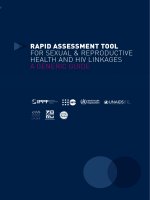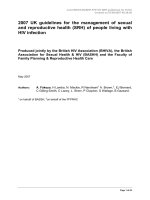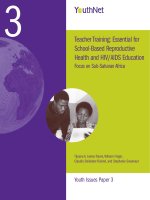ENLISTING THE ARMED FORCES TO PROTECT REPRODUCTIVE HEALTH AND RIGHTS: LESSONS LEARNED FROM NINE COUNTRIES ppt
Bạn đang xem bản rút gọn của tài liệu. Xem và tải ngay bản đầy đủ của tài liệu tại đây (508.28 KB, 99 trang )
ENLISTING THE ARMED FORCES TO PROTECT
REPRODUCTIVE HEALTH AND RIGHTS:
LESSONS LEARNED FROM
NINE COUNTRIES
TECHNICAL REPORT
Technical Support Division
Culture, Gender and Human Rights Branch
Copyright © UNFPA New York, 18 August 2003
ISBN 0-89714-676-X
www.unfpa.org
2
FOREWORD
UNFPA has been at the forefront of involving men in reproductive and sexual health for
decades, and especially since the International Conference on Population and
Development (ICPD, 1994). Over the years, we have learned a great deal about how to
positively engage men to take charge of their own reproductive and sexual well-being
and support that of their partners. One of the fundamental lessons is to reach out to men
where they are rather than expect them to seek out reproductive and sexual health
information and services.
Employment-based programmes have been one of the most successful ways of doing this.
Drawing on pre-Cairo successes with employment-based population and family life
education programmes, UNFPA has worked in several countries with a major employer –
the military – to introduce, expand and enhance reproductive and sexual health
information and services.
The enormous human, social and economic toll of HIV/AIDS and the increased
awareness of women’s vulnerability to gender-based violence, have given greater
urgency to this approach. Many countries have planned or are now implementing projects
targeting men in uniform as a way to promote HIV prevention, engage men as partners in
gender equity and the reduction of gender-based violence and improve their own and
their partners’ reproductive health status and protect their rights.
To map out what can be done in future interventions related to reproductive health and
gender equity within this key institution, this publication draws lessons from nine country
case studies and a global review of emerging programming and policy issues for enlisting
the armed forces in reproductive health, including preventing HIV/AIDS and promoting
gender equity. It starts by summarizing key lessons from the nine countries. This is
followed by an introduction, a synopsis of each case study, and a comparative analysis
drawn from the country findings. The comparative analysis examines what works in
successful programmes, what does not and what is left out. It also identifies remaining
challenges and opportunities. Finally, we outline global changes in the military context
relevant to future programming.
I trust that this review will stimulate debate, future programming and increased funding
to enlist armed forces as critical partners in both peacetime and conflict situations in our
national and international efforts to promote reproductive health and rights and gender
equity.
Mari Simonen
Director, Technical Support Division
UNFPA
3
ACKNOWLEDGEMENTS
Copyright © UNFPA New York, 18 August 2003
ISBN 0-89714-676-X
This publication and the case studies were made possible by:
A generous contribution from the Swedish International Development
Agency (SIDA)
UNFPA interregional and country programmes core funds
It was carried out under the direction of:
Mari Simonen, Director, Technical Support Division, UNFPA New York
Sylvie I. Cohen, Acting Chief, Culture, Gender and Human Rights Branch,
Technical Support Division, UNFPA New York, managed the project, conducted
research and wrote the report
In close collaboration with:
Margaret Arilha, CST Advisor, Latin America and the Caribbean
Michèle Burger, International Consultant
Manuel Carballo, International Consultant, IMCH
Pedro Garzon Castaneda, Former CST Advisor, Latin America and the Caribbean
Jimona Cilloniz, International Consultant, ICMH
Dr. Akinyele Dairo, Project Officer, Africa Division
Colonel Alexander Gudzovsky, National Project Director, Ukraine
Helen Jackson, CST Advisor, Southern Africa
Janet Jensen, Editor, UNFPA, New York
Dr. Tumurbaatar Luvsansambuu, National consultant, Mongolia
Dr. Oswaldo Montoya, National Consultant, Nicaragua
Luis Mora, CST Advisor, Latin America and the Caribbean
Yrene Ocampos, National Consultant, Paraguay
Jim Paige, International Consultant
Joseph Pitso, National Consultant, Botswana University
Andrey Poshtaruk, UNFPA project coordinator, Ukraine
Dr. Jean de Dieu Marie Rakotomanga, National Consultant, Madagascar
Dr. Azucena Maria Saballos, UNFPA Project Manager, Nicaragua
Dr. Jean Sehonou, National Consultant, Benin
Captain Anne-Mary Shigwedha, National Consultant, Namibia
Humberto Vaquero, National Consultant, Ecuador
Peter Lunding, Consultant, UNFPA, New York.
And effective support from the UNFPA staff, UNFPA Representatives and designated
UNFPA case study focal points in each country office, namely:
4
Edwige Adekambi, National Programme Officer, Benin
Alba Aguirre, UNFPA Representative, Ecuador
Bernard Coquelin, Former UNFPA Representative, Madagascar
Pamela Delargy, Chief, Humanitarian Reponse Unit, UNFPA New York
Philippe Delanne, UNFPA Representative, Benin
Linda Demers, Former UNFPA Representative, Mongolia
Dr. Ider Dungerjav, National consultant, Mongolia
Alexandrine Dzagobo, National Advisor on Reproductive Health, Benin
Manuelita Escobar, National Programme Officer, Paraguay
Tomas Jimenez, UNFPA Representative, Nicaragua
Mustapha Kemal, UNFPA Representative, Namibia
Agathe Lawson, UNFPA Representative, Botswana
Priya Marwal, Technical Officer, Humanitarian Response Unit, UNFPA, New York
Julitta Onabanjo, Senior Technical Officer, HIV/AIDS Branch, UNFPA, New York
Pierre Robinson, Assistant Representative, Madagascar
Dr. Soyoltoya, National Programme Officer, Mongolia
Dorcas Temane, Assistant Representative, Botswana
Borys Vornik, National Programme Officer, Ukraine
5
ABREVIATIONS
AIDS Acquired Immune Deficiency Syndrome
BCC Behaviour Change Communications (Formerly IEC: Information,
Education and Communication)
CST Country Technical Services Team
GBV Gender-based Violence
HIV Human Immunodeficiency Virus
ICPD International Conference on Population and Development
ICMH International Centre for Migration and Health
KAP Knowledge, Attitudes and Practices
PLWA People Living with AIDS
RH Reproductive Health
RSH Reproductive and Sexual Health
RR Reproductive Rights
STD Sexually Transmitted Disease
STI Sexually Transmitted Infection
SWAps Sector Wide Approaches
UNAIDS Joint United Nations Programme on HIV/AIDS
UNDPKO United Nations Department of Peacekeeping Operations
UNFPA United Nations Population Fund
UNIFEM United Nations Development Fund for Women
VCCT Voluntary and Confidential Counselling and Testing
VCT Voluntary Counselling and Testing
WHO World Health Organization
6
CONTENTS
Acknowledgements
Abbreviations
Executive Summary of Key Findings and Lessons
Institutional opportunities and challenges for the partnership
Building human capacity to address reproductive health, HIV and gender equity
Behaviour change communication strategies
Providing quality reproductive health services, including HIV/AIDS prevention
Addressing gender issues
Tapping political will
Mobilizing more resources
Recommended next steps for donors
Introduction
Rationale for the study
The ICPD vision: Benefits of partnering with men in the military
Conceptual framework
Methodology: Where and how?
Limitations of the study
Synopsis of Country Case Studies
Benin
Botswana
Ecuador
Madagascar
Mongolia
Namibia
Nicaragua
Paraguay
Ukraine
Comparative Analysis of the Nine UNFPA Country Case Studies
National contexts
Entry points for the projects
Cross-sectoral collaboration
Human capacity strategies
Behaviour change communication strategies
Reproductive health service delivery strategies
Promotion of gender equity
Institutionalization and prospects for expansion
Changing Contexts for Partnering with the Armed Forces on Reproductive Health,
HIV and Gender Issues
7
Changing roles, demographics and socio-economics of national military forces
Growing numbers of female military personnel
Military in national budgets: a privileged sector in developing countries
Increased attention to vulnerabilities of military personnel
Unequal power relations between armed forces and civilians
Global agreements
Opportunities for change and emerging good practices in prevention
Challenges for HIV prevention in the military
Policies governing military life, including family relations
Human rights issues
Unresolved gender issues
Conclusion
Conclusion: The Military Institution as a Social Change Agent
References and Other Sources
Annex: A Comparison of Military, Education and Health Expenditures in
Developing Countries
8
EXECUTIVE SUMMARY OF KEY FINDINGS AND LESSONS
Background
This comparative study of country experiences across regions was undertaken as part of a
UNFPA interregional project ‘Improving Gender Perspective, Reproductive Health and
HIV/AIDS Prevention through Stronger Partnership with the Military’ (project number
INT/01/PM3). It was conducted by UNFPA’s Technical Support Division, with generous
support from the Swedish International Development Agency and through collaboration
with the UNFPA Technical Assistance Programme regional advisors, country offices and
national consultants.
Its purpose is to inform future programming by identifying effective approaches for
working with men in the uniformed services in reproductive and sexual health from a
gender perspective. Although UNFPA has long cooperated with the military in the areas
of family planning and family life education, its growing cooperation with an institution
that operates in unique political and social contexts – in times of peace or conflict – has
not been well documented. Experience sharing is needed to scale-up or sustain effective
interventions and guide future programming. Cross-regional exchange of experiences is
expected to enhance UNFPA’s practical knowledge and leadership role in an area where
it clearly has a comparative advantage regarding gender issues, reproductive
health/reproductive rights promotion, and the fight against HIV/AIDS. Equipped with
practical insights into the implementation process, UNFPA offices and their national
partners should be able to improve existing programmes or introduce new ones.
To compare implementation strategies in the military that integrate reproductive and
sexual health and gender issues, we established a conceptual framework to review the
nature of the partnership; the extent and quality of reproductive health services and
information, including for HIV/AIDS prevention; and gender mainstreaming.
Country experiences are from: Benin, Botswana, Madagascar and Namibia in Africa;
Ecuador, Nicaragua and Paraguay in Latin America; Mongolia in Asia; and Ukraine in
Eastern Europe.
The case studies focused on institutional changes, rather than actual impact on
epidemiology and behaviour. They sought to identify the range of implementation
approaches used so far, their commonalities and differences. A common query was: What
is working and needs to be continued or expanded? What is not working and needs a new
more strategic approach? And finally, what has not been addressed at all?
The main lessons follow:
9
Institutional opportunities and challenges for the partnership
Selecting a strategic focus for the partnership between donors and armed forces
The projects reviewed fell in three broad categories, focusing on:
• Prevention of HIV and other sexually transmitted infections in Botswana
Mongolia and Namibia;
• Improvement of armed forces’ reproductive health service delivery capacity in
Benin; Ecuador, and Madagascar;
• Educating military personnel about population and reproductive health issues, in
Botswana and Ecuador, and integrating reproductive and sexual health services
and education in Nicaragua and Paraguay.
The review examined if and how the origin of the project – including its funding source,
and whether it derived from earlier projects – affected the attention given to gender
issues, quality of care and broader reproductive health messages as well as the project’s
prospects for scaling-up and institutionalization.
Since most of the projects studied did not conduct a needs assessment at the outset,
strategic design decisions, such as the selection of priority beneficiary groups, depend on
the degree of verticality of the intervention and preferences of donors, rather than on
actual needs.
In peacetime, a larger difference in the focus of the reproductive and sexual
health interventions with the armed forces seems to account from donor’s
interests rather than country-specific development context and lessons learned
from experience. Another is the visibility of the HIV/AIDS epidemic in the country.
Donors may need to show short-term results, and hence, take a vertical
approach. However, in order to implement the comprehensive ICPD vision,
projects with the military should attempt to expand from the vertical and short-
term programmatic approaches to HIV/AIDS prevention -favoured by many large
donors- and encompass all components of reproductive health, including quality
of care, reproductive rights, and gender-based violence, and mainstream gender
in laws and codes of conducts.
Most projects supported by HIV-focused funds, such as UNAIDS, tend to address HIV
prevention in a rather vertical and medical manner; much less attention is given to other
reproductive health components such as family planning, maternal and child health, and
gender perspectives. Even though these projects focus on prevention, critical components
such as voluntary counselling and testing (VCT), sustainable condom provision and
10
education on gender sensitive relations, seem to have been an after-thought, and the
reproductive health services component is limited.
Moreover, many of the surveyed HIV-only projects focus on educating young male
soldiers and conscripts, but leave out higher-level officers, service providers, permanent
staff, female staff, and civilian populations.
On the other hand, the broader reproductive health projects, which stem from former
family planning or population education activities, try to address larger concerns and take
a more comprehensive approach to reproductive health. When these projects contributed
to building a reproductive health infrastructure, they tended to focus more on service
delivery and less on education for behaviour change. However, the addition of an HIV
prevention component – especially provision of condoms – is often an after-thought.
Most projects on rehabilitation of reproductive health services encompass service
providers, families of permanent staff and in some cases, surrounding civilian
populations. They tend to overlook the needs of young recruits.
Who to work with inside the institution?
Most projects favour one department over others, often either the health or
training departments, but rarely both.
Because the choice of a lead department is critical to the success of a project, a
thorough understanding of military structure and its culture is essential to
effectively channel support to project activities.
A major challenge to integration and coordination among departments comes
from the organizational structure of the military itself, which is typically
compartmentalized and hierarchical. Advocacy at the highest level possible, to
promote the benefits of working across departments or divisions, is needed. Mid-
level health officers will rarely have the clout to influence activities outside of their
own department – orders from above are needed to make this happen.
Choosing the lead department to implement a project is a key strategic decision. This
decision affects not only the overall focus and strategies of the intervention – for
instance, the balance between education and service provision – but also the prospects for
institutionalization and expansion.
Unfortunately, the choice of the department often reflects the history of the project and its
previous entry points, rather than a well thought-out strategy. The choice of lead
departments to manage the project is not always based on a feasibility study and
knowledge of the military structure.
Different departments have different comparative advantages. Health departments, for
instance, afford access to the military health service delivery infrastructure and can
11
facilitate reproductive health service delivery. However, since they are often staffed
primarily by women, health departments tend not to have a great deal of clout throughout
the institution as a whole. Thus, health interventions may not permeate pre-service and
in-service training of officers and soldiers.
Training departments, on the other hand, offer access to strong training infrastructures,
including military academies and in-service training programmes. Their participation is
critical to the institutionalization of projects. However, working with the training
department alone may be counterproductive if it creates an unmet demand for
information and reproductive health commodities and services. Social welfare, recreation
and communications divisions can reach and influence military personnel in other
dimensions of their day-to-day life, which can facilitate and reinforce attitudinal and
behaviour changes.
Ideally, the health and training departments should work together in leading these types
of projects. An integrated approach is recommended for implementing projects with a
broad reproductive health perspective that incorporates gender issues. This might include
working with several departments at once, including health, training, recreation,
communications and social welfare.
Another common flaw in projects reviewed is a lack of coordination of efforts among
departments within the military, especially health and education, military academies and
various other arms of the organization.
Cooperation between the military and other public agencies in health, education and
youth is growing in the context of national responses to HIV/AIDS, but is still minimal.
Similarly, lack of coordination among donor-funded military projects is endemic.
The hierarchical military structure seems to limit the amount of integration and lateral
communication that can occur among the different elements of a reproductive health
programme. For instance, even in projects where courses on reproductive health have
been institutionalized and required in all units, little interaction between trainers and
service providers was reported.
The importance of collaboration with other social sectors, including civil society
The military sector should be invited to contribute to population and development
committees and task forces, including national AIDS commissions, poverty
reduction task forces, multi-sectoral coalitions on reproductive health and
gender-based violence, including SWAps, at national and decentralized levels.
Civil society organizations have a valuable and welcome role in integrating
reproductive health programming into the military arena. One could encourage
further use of civil society organizations for technical assistance.
12
Collaboration with other government agencies with experience or mandates in
reproductive health and HIV/AIDS prevention and promotion of human security (such as
health, education or interior security forces) is quite uneven and happens more easily at
decentralized levels.
On the other hand – and contrary to the perception of military organizations having a
‘closed’ approach to outsiders – the military in many countries studied appear quite
receptive to technical cooperation from civil society organizations in the areas of
reproductive health, gender and population issues. Contributions from civil society have
been particularly welcome in curriculum development, training of trainers, and behaviour
change communication. Key challenges for this kind of collaboration rest on increasing
transparency to promote human rights-based programming, and sharing information and
evaluation data.
Building human capacity to address reproductive health, HIV and gender
equity
A workplace that presents specific cultural and policy challenges
The hierarchical organization of the military, coupled with a predominantly
masculine culture poses specific policy challenges for furthering the values and
longer-term perspectives embodied in the ICPD vision.
However, military leaders are quite interested in collaborating on reproductive
health issues, including family planning and HIV/AIDS, and, to a much lesser
extent, depending on the context, on maternal health and gender-based violence
issues.
The political will to introduce reproductive and sexual health into the military
arena is present and should be leveraged. This commitment seems to stem from
the military elites’ sense of social responsibility for the health of their workforce or
a desire to assist civilian populations in crisis. In any case, their concern serves
as a valuable entry point for collaborating in reproductive and sexual health and
for introducing gender perspectives.
However, one should not underestimate the policy advocacy efforts needed to
change policies. Policies that address family leave, length of deployment,
housing and accommodations, recreation and recourse to sexual services work,
condom policies, place and role of women, and treatment of staff living with
AIDS, need to be reconsidered as these issues contribute to risky behaviours
and environments, and perpetuate gender inequality.
First of all, the hierarchical, authoritarian and masculine military culture in some respects
clashes with many of ICPD’s principles of individual empowerment. For example,
military institutions tend to condone risk-taking behaviours and are known more for
13
enforcing conformity to stereotypical norms of virility than for tolerance of more gender
sensitive attitudes and practices.
Although the HIV/AIDS pandemic is forcing some military leaders to deal with the
sexual health and the social and psychological needs of soldiers, the tendency has been to
ignore or deny these issues. Many military officers avoid discussing soldiers’ needs for
recreation, companionship and power, and the possibility of resorting to sex workers or
same-sex sex partners, drug or substance abuse, stigma and discrimination, gender-based
violence, and domestic violence in times of stress.
Consequently, voluntary counselling and testing, care for people living with AIDS and
reproductive rights issues are weak, if not completely missing, components of the
military projects reviewed.
There is even less consensus about addressing the reproductive and sexual health needs
of female partners and female staff as well as other aspects of gender equity such as
sexual harassment, domestic violence and gender-based violence in the codes of conduct.
Thus, a major challenge remains as to how to creatively and effectively deal with the
apparent clash between military culture and ICPD values.
Training human resources
Training and capacity building in reproductive health are prerequisites to
institutionalization of reproductive health and reproductive rights. Tapping the
military’s well-established training and health infrastructure, and establishing a
core group of trainers and providers in reproductive health and HIV, emerged as
two successful strategies in this regard. However, monitoring mechanisms to
introduce lasting changes, after initial training of trainers, are weak.
More emphasis needs to be placed on institutionalization of capacity building.
Since military organizations have tremendous resources and longevity, projects
that become institutionalized within them can be transformational.
Toward this end, the initial project agreement with the military should include
plans for:
- Conducting needs assessments of instructors and providers
- Integrating curricula on reproductive health, including HIV/AIDS and gender and
human rights issues, in military academies
- Scaling it up to all bases and divisions, and
- Adopting clear monitoring and evaluation mechanisms.
14
Training in reproductive and sexual health was being well integrated into the military
curriculum in four of the nine countries studied – Ecuador, Nicaragua, Paraguay and
Ukraine.
However, training activities are inadequate in most of the other projects reviewed. Except
when it is included in academic training, on-the-job training is a short, one-time event,
and refresher training is deficient. Special attention needs to be given to maintaining
training activities, especially since military personnel move around frequently.
When the project is implemented in a top-down manner, training of trainers tends to
follow a fairly standard cascade approach. When the project is geographically focused,
local workshops are more inclusive of all personnel and ranks.
Institutionalization requires a long time frame and formal structures for monitoring and
evaluation. For that reason, projects that can show tangible results will have better
prospects for institutionalization. However, few projects among those reviewed had
conducted knowledge, attitudes and practices (KAP) surveys to measure impact of
educational activities on trainers, service providers and young soldiers. Attitudes, beliefs,
and behaviour are not regularly assessed and consequently, changes are difficult to gauge,
except anecdotally.
Behaviour change communication strategies
Content and participatory process
Participatory educational and communication methodologies, including peer
education, are known to be more effective for behaviour change in confined
environments such as prisons and military bases, but their adoption may be at
odds with traditional military approaches.
Military teaching methodologies tend to be didactic and focus on knowledge
transfer. Attitudes, beliefs, and behaviour are not regularly assessed and
changes are difficult to gauge, except anecdotally.
Messages and topics for discussions focus on imparting biomedical knowledge of family
planning, HIV transmission, maternal and child health, and human anatomy. More rarely
do they address lifestyle, gender and ethical issues, or deal with feelings, beliefs and life
skills including communication, empathy, stress management and conflict resolution.
Some projects, however, used innovative approaches such as peer education schemes,
use of supportive lieutenants as role models, incentives for peer promoters, community-
based distribution of condoms, and alliances with local social marketing schemes for
condom procurement and revolving funds. A few of the projects reviewed (notably,
Botswana, Mongolia and Nicaragua) incorporated participatory methods with some
success.
15
Few projects among those reviewed had conducted knowledge, beliefs, attitudes and
practices surveys to measure impact of educational activities on trainers, service
providers and young soldiers.
Providing reproductive health services, including HIV/AIDS prevention
Range and quality of services
Reproductive health services offered on the base vary between regions, and
quality of care is not much of a concern. Forecasting and meeting the needs in
reproductive health commodities was found to be weak as well.
More attention should be given to quality of care issues in reproductive health,
the integration of HIV into a reproductive health framework, and to the needs of
permanent staff, including female contractual staff and family members.
In Africa and Latin America, health services tend to be more comprehensive and include
reproductive health services for families and civilians, while in Asia and Europe, they
may be limited to first aid care of young conscripts. Most health personnel in the military
are female (and contractual) staff.
In general, the reproductive health needs of permanent staff, including officers, and
contractual staff, are neglected at several levels. Accessibility to civilians and military
families depends on the location of bases and differs from country to country. Civilians
tend to be excluded from training and from receiving reproductive and sexual health
services, including consciousness-raising workshops that aim to change attitudes and
behaviours and provide information about rights and obligations.
In general, the services provided through military clinics at the primary level do not meet
the standards established by the ICPD. In particular, the counselling skills of health
providers in the areas of sexuality and reproduction, and conditions for privacy and
confidentiality of counselling and testing for sexually transmitted diseases, including
HIV, are deficient. Private counselling, including confidential VCT, is lacking, except in
high HIV prevalence countries. Sexually transmitted infections (STIs) are managed
through a syndromic treatment approach.
Forecasting the needs for and distribution of family planning methods, male and female
condoms, HIV/STI tests or drugs were found equally weak. Because of the observed
deficiencies in availability of services, including tests, drugs and condoms, a demand is
more easily created for condom use than satisfied and enforced.
Recurring weaknesses in condom programming
16
Condom programming, in many projects, consists mainly of condom promotion.
There is an urgent need to promote a culture of consistent condom use for dual
protection, complemented by readily accessible and affordable male and female
condoms so the people can act on the information they receive. Strategic
moments to organize campaigns, such as leave and demobilization, should be
seized.
Reproductive health projects cannot assume that condoms will be procured in a
sustainable manner. None of the projects studied had adopted a satisfactory
procurement system for condoms.
The military needs to strengthen its sense of ownership of reproductive health
commodity security matters and increase its capacity in terms of condom
procurement and distribution, using a marketing perspective that includes equal
attention to clients’ needs and preferences, pricing, placement and distribution.
Condom use was well promoted in most projects reviewed, although there is no data to
support evidence of condom use.
Timely, affordable and user-friendly access to condoms, however, needs more emphasis.
Organizing access to condoms for both permanent staff and conscripts was found to be
deficient. Systems for procuring reproductive health commodities are better handled in
projects that included family planning and maternal and child health service delivery
components.
Very few projects – with the exception of Benin, which is installing automatic condom
dispensers – take user perspectives into account when planning distribution. Some
military divisions hand out condoms as a matter of course to soldiers taking off on leave.
The main challenge is that, in both reproductive health services and HIV-only projects,
neither the military leaders nor the donors consider condom distribution a priority or a
responsibility, although they could take full advantage of peer distributors, on-base health
units, and collaboration with local health authorities.
Confusion about HIV testing
There is a need to clarify testing policies for peacekeepers, and other staff and
recruits. HIV testing needs to remain voluntary and be accompanied with proper
counselling, and policies of right to work, access to care, treatment of people
living with AIDS and social welfare.
17
VCT is rare. However, hidden and compulsory HIV screening and testing of young
recruits is being conducted by the military in a number of countries through blood
donation schemes.
Clearly, the cost of treatment and retraining are major financial concerns of the military
of resource-poor countries, and affects how persons living with AIDS are dealt with. In
that regard, policies differ significantly between young recruits and permanent staff.
It does not help that the UN position is also unclear with regards HIV testing. WHO and
UNAIDS emphasize that mandatory HIV testing risks violating basic rights to privacy,
and freedom from socio-economic and political discrimination. They also assert that
mandatory testing fails to prevent HIV transmission. DPKO does not require mandatory
testing from troop-contributing countries and advocates for Voluntary Counselling and
Testing (VCT). However, a person who has an active disease, including AIDS, cannot be
deployed to a peacekeeping mission. Joining the international peacekeeping forces is a
lucrative source of income for the armed forces of developing countries; in this context,
troop-contributing countries sometimes interpret VCT and future peacekeepers are
compelled to carry out ‘voluntarily’ undergo testing.
Addressing gender issues
Unmet women’s needs in reproductive health
Most of the projects exhibited a gender bias, and met the needs of men more
fully than those of women. Though this can be attributed, in part, to the fact that
the targeted beneficiaries were predominantly men, gender perspectives need to
be better integrated into projects.
Women in the military need a voice, equal access to opportunities and equal
protection by laws. Gender perspectives need to be better integrated into project
design and monitoring and in codes of conduct.
Most military organizations do not address such issues as power in sexual relations, nor
do they challenge the dominant model of masculinity, which does not discourage men
from having multiple partners. Thus, the key prevention messages the reproductive and
sexual health projects promote are often at odds with military attitudes.
In the cases reviewed, this translates into reproductive health and HIV/AIDS prevention
projects that inadequately meet gender equity needs in the following manner:
• Projects work with men in isolation from women’s groups [on base or civilians].
• Women staff, contractual personnel and family members are not included as
beneficiaries for access to information, services and rules that promote safe sexual
relations.
18
• Projects assume that: women do not need STI testing and treatment, nor other
reproductive health services; they do not have easy access to reproductive health
services, including maternal health, family planning, emergency contraception,
emergency obstetrics, and HIV post-exposure prophylaxis.
• Condom promotion aims only at changing risky behaviours with so-called ‘risk
groups’ such as sex workers.
• Condom promotion exploits traditional gender roles to promote condom use.
• HIV prevention education describes HIV transmission using the medical model
but leaves out the element of gender relations.
• No gender specific counselling services are offered.
• Men are not specifically involved as gender equitable partners in reproductive
health and HIV.
Enforcing changes in codes of conducts
The ICPD principles of women’s empowerment, partnering with men and rights-
based approaches to the elimination of gender-based violence, could be
promoted as a foundation to inspire the revision of military codes of conduct and
labour policies, to address relations with civilian populations, safer lifestyles, and
clarify ethical, legal and constitutional aspects of reproductive health, HIV
prevention and care, and gender relations.
Codes of conduct are often overlooked as powerful avenues for promoting and enforcing
acceptable standards of behaviour. However, in the codes reviewed, gender issues and
partnership between men and women are neglected. And in the labour policies,
reproductive health needs and related rights of women in the workforce and female
family members seem to have been left out.
Examples of gender equity needs that are not addressed in military policies include:
• Staffing policies, including those of service providers, that address equal
career opportunit;
• Inclusion of women in the creation of training curricula on lifestyles and
reproductive health/HIV, so as to reduce gender stereotyping;
• Safe spaces for debating about masculinities, sexuality, violence, and risk
cultures;
• Code of conducts and military courts that incorporate gender-based violence
and other safety concerns;
• Equal access to external in-service training resources, including women’s
participation in in-service training workshops, as trainers and trainees.
New behavioural and ethical policies are rarely codified, except for peacekeeping
personnel who need to abide by DPKO recommended rules of conduct, and in countries
on their way to democratization, where the army is redefining its societal role and social
responsibility in development and protection of human rights.
19
Despite these limitations, the formal, top-down structure of military institutions suggests
that the written codes of conduct may be a powerful place to affect change. However,
codes of conducts are under-utilized for promoting and enforcing new standards guiding
ethical behaviour, gender equity, and social responsibility. Changing the code in most
cases will require buy-in from the highest military and governmental levels.
Tapping political will
Advocacy needs to be addressed systematically
Political will at the highest level of national leadership is critical to successful
projects with the military. It is a prerequisite for getting buy-ins from the other
departments and military base officers. Nevertheless, efforts to gain high-level
support are often overlooked, poorly organized or not sustained. Having personal
access to military leaders is a definite advantage in this regard.
Advocacy efforts that appeal to the self-interest of the military, such as keeping
its workforce in good health, or enhancing its humanitarian role in emergencies,
tend to be more successful than convincing it to accept to address more general
cultural, societal and ethical concerns.
In all nine cases studied, the military leadership expressed strong commitment to protect
its staff against the risks of sexually transmitted infections, including HIV, through
education and condom use, and to consider the positive societal effects of turning young
men into responsible fathers.
This interest can be nurtured through advocacy efforts, by enlisting military participation
in national population commissions and HIV/AIDS theme groups, and in response to
humanitarian crisis.
Wives of high commanders and female officers can also be tapped as advocates, as they
often play a ‘first lady’ leadership role at garrison level. They often take the lead in
organizing spouses’ associations and committees, and in initiating counselling and
training of female personnel and spouses on family separation issues, gender-based
violence and reproductive health concerns. They also seem to be better listeners to the
needs of young soldiers and of people living with AIDS.
However, it is easy to underestimate the time and effort required to achieve solid
commitment of senior staff. This involves ongoing advocacy to raise awareness about the
relevance of reproductive health, HIV/AIDS and gender equity issues to the military.
The challenge is also to translate the current level of interest into long-term, widespread
and coordinated institutional changes in resource allocation, training, family policies,
services and conduct codes, and in carefully raising gender and rights issues in ways that
20
do not cause a defensive reaction. An effective strategy in this regard is to promote pilot
project activities and make them visible among the highest military ranks.
There is no consensus within the armed forces and among donors about roles codes of
conducts can play in enforcing behaviour change and protection and respect of women or
powerless groups.
Advocacy needs to address a number of issues, among them:
• Collaboration among key military departments, including the academies and other
ministries, to manage the reproductive health/HIV/GBV projects; and acceptance
of technical assistance from civil society organizations that are knowledgeable
about specific reproductive health, gender and human rights related topics;
• Mobilization of internal resources for sustained training and provision of
reproductive health commodities, including condoms;
• Broadening leaders’ understanding of reproductive health and HIV issues, not
only in terms of prevalence and medical consequences, but also in terms of family
life and gender relation issues, interactions with civilian populations, gender-
based violence, and poverty;
• Integration of reproductive and sexual health and gender equity curricula into
military academies and in-service training;
• Accessibility and quality of reproductive health care improvements, including
privacy and confidentiality in counselling, HIV ethics and status of people living
with AIDS;
• Reliable and user-friendly condom procurement, including female condoms;
• Policy changes in housing that prevent occurrence of sexual abuse; leave policies
that include easier communication with spouses and partners; gender equitable
staffing policies that also apply to medical personnel; and amending the codes of
conduct so that they enforce training standards and correspond to promoted
norms.
Experience exchange and knowledge sharing
Armed forces seem very keen to know more about successful experiences in
other countries and regions. Taking stock at the national level is also valuable in
terms of knowledge sharing, spreading word of successful and innovative
programming ideas, and expanding projects to include other groups, such as
national police.
21
National conferences of military implementing units help build understanding, support
and enthusiasm for reproductive health projects. They also serve to promote innovative
and successful initiatives such as:
• Peer group discussions, in addition to training sessions;
• Peer-based condom distribution;
• Training and rewarding of peer educators;
• Using officers as role models to demystify readiness to condom use;
• Organizing recreational activities and contests with a theme on reproductive
health or HIV;
• Establishing recreational corners or rooms and counselling facilities to talk about
safer sexuality and relationships among same ranks, between ranks and with
female partners.
Mobilizing more resources
From donors
In general, the funding allocated to projects was too small to accomplish or
sustain project goals. In particular, resources for materials and commodities were
inadequate, leaving projects without adequate funding for replenishment of
training materials and procurement of condoms to meet increased demand.
Unlike many other ‘higher risk target groups’, the military is seldom considered
an appropriate recipient of donor support for implementation of reproductive
health and HIV prevention programmes. The CivSil Military Alliance very rightly
has alerted donors that they must understand the urgency of greater external
support for the defence establishment to scale up prevention efforts, or risk
losing the progress that has been made thus far. In this regard, UNFPA has a
definite comparative advantage, based on its partnership experience with this
sector and for consistently advocating for comprehensive, long-term approaches.
The UNFPA projects begin fairly modestly in terms of size and scope and scale up
progressively. Projects from other donors, such as USAID, tend to be much larger but
more limited in time and scope (for instance, by tackling HIV/AIDS as a vertical issue,
separate from reproductive health and gender).
Overall, project designs did not address the issues of institutionalization and
sustainability of reproductive health, particularly re-supply of commodities and
educational materials, and equipment maintenance.
Approaches to make reproductive and sexual health projects financially viable and
sustainable are needed. One potential avenue is for the military to publicize their efforts
on behalf of civilian populations and their staff. Such efforts may attract funding from
other donors, and affect national budgetary decisions. Another strategy is to build
22
capacity of the military in fundraising, and in preparing joint proposals with ministries of
health and education.
Recommended next steps for donors
To-date, UNFPA has taken an important, and to some extent, leading role with respect to
reproductive health, HIV/AIDS prevention and gender issues in relationship to the
military. The magnitude of the challenge before the United Nations and the international
community as a whole nevertheless calls for far more concerted and consolidated action.
The findings of this assessment lead us to recommend the following specific initiatives:
Preparation and diffusion of programming guidelines on reproductive health and
HIV/AIDS prevention, gender equity promotion and prevention of gender-based
violence within the military, and between the military and civilian sectors and
communities;
Adaptation of these guidelines to the specific needs and characteristics of
different military forces and groups, including the needs of women as staff,
spouses, service contractors and neighbours;
Strategies to ensure reliable procurement of reproductive health commodities,
including supplies and re-supply of condoms, reproductive health supplies and
culturally adapted educational materials;
Preparation and implementation of a series of KAP surveys that can be used in all
military forces and provide the basis for behavioural surveillance, and for inter-
country evaluation of progress and exchange of experiences with a view to
facilitating resource mobilization;
Preparation of additional case studies that describe the ways in which HIV/AIDS
prevention and prevention of gender violence is taken up by different military
forces, especially in low prevalence countries such as Senegal and Morocco, and
in conflict and emergency situations, providing special attention to ‘good
practices’;
Organization of a series of knowledge sharing regional and inter-regional
workshops and seminars that will help strengthen collaboration between different
military forces, and enhance military civilian relationships;
Preparation over the next five years of annual reports on all of the above and
inclusion of additional information that would be useful to military forces in
planning and preparing their work in these areas.
23
INTRODUCTION
Rationale for the study
The armed forces are central to the good governance of a country, not merely in terms of
their defence role but also as a development agent. Military leaders are increasingly
aware that they do not serve in isolation and that some attention has to be given to the
well-being of their personnel, military families and to civilians with whom the military
comes into contact.
Armed forces also play an important humanitarian role. Recent emergencies – for
example drought and fires in Mongolia, earthquakes in Turkey, hurricanes in Central
America – all involved large scale operations by the armed forces of those countries.
Furthermore, armies may be involved in local and regional conflicts or may be involved
in international peacekeeping operations. Especially in countries whose armed services
are augmented by conscript soldiers, the military reach large sections of the population
not otherwise easily accessible
1
.
Although UNFPA has long cooperated with this institution in the areas of family
planning and family life education, its growing cooperation with an institution that
operates in unique political and social contexts – in times of peace or conflict – has not
been well documented. Experience sharing is needed to scale-up or sustain effective
interventions and guide future programming.
Comparing experiences of different countries in partnering with the military to involve
men in reproductive health, including HIV/AIDS and gender-based violence, with a
gender perspective, is useful because:
Reproductive health goals, including HIV prevention, require men to be part
of the solution.
The army is a male-dominated institution that reaches large cohorts of men at
a young age.
There is a clash between a male-dominant hierarchical and often aggressive
institution and the introduction of content related to democratizing and
equalizing gender relations.
Armies are undergoing demographic and socio-economic changes that impact
on their vulnerabilities and readiness to address reproductive health, HIV and
gender issues.
The HIV/AIDS epidemic is getting worse, including in the military.
The army is mandated to work as partners in HIV/AIDS prevention and in
eliminating gender-based violence by international agreements.
The army is a strong and important public institution, with expedient training
programmes, medical infrastructures and disciplinary rules.
1
Curran, L. 2001. ‘HIV Prevention in the Army of the Ukraine’. Draft. UNAIDS Best Practice Case Study.
Kiev, Ukraine.
24
Donors are starting to support efforts to improve the reproductive health and
HIV situations but lack knowledge on how to best use their resources.
Armies are eager to learn from each other’s strategies beyond their regions.
This comparative study of country experiences across regions was undertaken as part of a
UNFPA interregional project ‘Improving Gender Perspective, Reproductive Health and
HIV/AIDS Prevention through Stronger Partnership with the Military’ (project number
INT/01/PM3). It was conducted by UNFPA’s Technical Support Division, with generous
support from the Swedish International Development Agency and through collaboration
with the UNFPA Technical Assistance Programme regional advisors, country offices and
national consultants.
Its purpose is to inform future programming by identifying effective approaches for
working with men in the military and uniformed services in reproductive and sexual
health from a gender perspective. Cross-regional exchange of experiences is expected to
enhance UNFPA’s practical knowledge and leadership role in an area where it clearly has
a comparative advantage regarding gender issues, reproductive health/reproductive rights
promotion, and the fight against HIV/AIDS. Equipped with practical insights into the
implementation process, UNFPA offices and their national partners would be able to
improve existing programmes or introduce new ones.
The ICPD vision: Benefits of partnering with men in the military
Guided by the ICPD principles, the analysis framework is based on a conviction that
partnering with men in the military can help achieve the following results
2
:
Increase the likelihood that both men and women will make informed, safe and
consensual decisions regarding sexuality and reproduction;
Reduce men’s vulnerabilities by altering their attitudes, beliefs and practices
regarding risk-taking;
Inculcate men’s respect for human rights entitlements that relate to reproductive and
sexual health;
Encourage gender equity and promote freedom from gender-based violence;
Enlist young men as allies in gender equity and reproductive and sexual health;
Enhance perceived value of the girl child; and
Produce reproductive health improvements for everyone such as:
• Reducing sexually transmitted infections, including HIV/AIDS;
• Offering greater choice of family planning methods;
• Reducing unwanted pregnancies and increasing preparedness for safe
motherhood;
• Avoiding harmful practices, such as female genital cutting, early or forced
marriage, and sex-selected abortions;
2
UNFPA. 2002. ‘It Takes Two: Partnering with Men in Reproductive and Sexual Health’. Programme
Advisory Note. New York: UNFPA.
25
• Reducing violence, especially violence against women and other intimate
partners.
Conceptual Framework
To compare implementation strategies in the military that integrate reproductive and
sexual health and gender issues, we established a conceptual framework to review the
nature of the partnership; the extent and quality of reproductive health services and
information, including for HIV/AIDS prevention; and gender mainstreaming. The
framework contains the following categories that are analyzed cross-sectionally:
Historical entry points for the projects (focus of projects: RH or HIV/AIDS or
both)
Cross-sectoral collaboration (among armed force units; with other public
agencies; with civil society; and with donors)
Human capacity strategies (who is trained in what topics, and how)
Behaviour change communication strategies (audiences; content and participatory
process)
Reproductive health service delivery strategies (including integration of
HIV/AIDS prevention, counselling and condom programming)
Promotion of gender equality (mainstreamed, scattered or left out)
Institutionalization and prospects for expansion (vertical project approach or
institutionalized; origins of resources)
The case studies focused on institutional changes, rather than actual impact on
epidemiology and behaviour. They sought to identify the range of implementation
approaches used so far, their commonalities and differences. A common query was:
What is working and needs to be continued or expanded? What is not working and
needs a new more strategic approach? And finally, what has not been addressed at
all?
Methodology: Where and how?
The selection of countries was based on anecdotal knowledge of success stories and the
willingness of the UNFPA Representative to accommodate the fact-finding mission. We
also tried to include as much variety of regions and approaches as possible.
Experiences are from: Benin, Botswana, Madagascar and Namibia in Africa; Ecuador,
Nicaragua and Paraguay in Latin America; Mongolia in Asia; and Ukraine in Eastern
Europe.
The study gathered qualitative data, using rapid assessment methods, including secondary
data, in-depth interviews, and focus group discussions. Based on a common data
collection protocol and case study structure, local consultants conducted desk reviews
prior to the fieldwork by local and international consultants. In-depth interviews included
key stakeholders such as army project leaders, health providers, trainers and other armed









